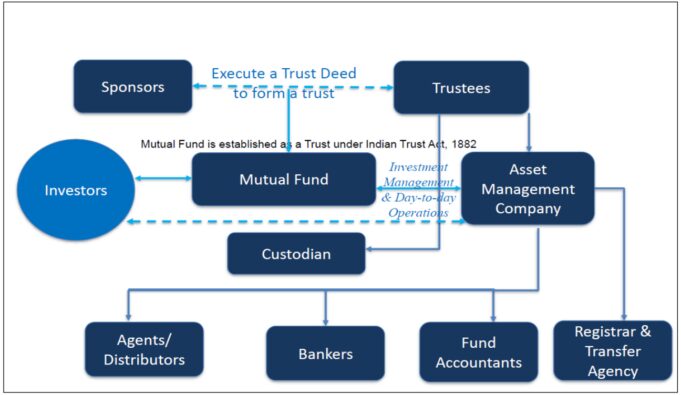In their essence, mutual funds are investment vehicles that pool money from multiple investors to invest in a diversified portfolio of securities. They offer individual investors access to professional portfolio management and a diversified investment strategy.
In the world of investment, mutual funds stand out as a popular vehicle for investors aiming for diversified exposure to various securities. As different types of mutual funds offer unique advantages and limitations, understanding their structural differences is paramount. “Mutual Fund Structures: Exploring the Three Basic Types and Their Features” offers a comprehensive insight into the three fundamental mutual fund structures: open-end funds, closed-end funds, and exchange-traded funds (ETFs). This guide delves into the key characteristics, operational aspects, and investment strategies of each type, enabling investors to make informed choices aligned with their financial goals and risk tolerance.
Choosing the right structure for funds is essential as it governs the way the fund manages assets and chooses investment strategies. This is your short guide to three main mutual fund structure types.
Overview of mutual fund structures
There are three main types of mutual fund structures. Each of them has its own management specifics and other unique features.
Open-end funds

Open-end funds are the most common type of mutual funds. These funds issue new shares to investors and redeem existing shares daily. The number of shares in an open-end fund is not fixed and can fluctuate based on investor demand.
This type of funds can be typically actively managed, meaning the fund manager makes investment decisions to achieve the fund’s objectives. Investors buy and sell shares at the net asset value per share, which is calculated daily based on the fund’s assets minus liabilities.
Closed-end funds

Closed-end funds differ from open-end funds ‒ they have a limited number of shares. These funds conduct an initial public offering to raise capital, and after it’s over, the shares trade on a stock exchange like any other publicly traded stock.
Closed-end funds are also actively managed and usually they invest in various securities. Unlike open-end funds, closed-end funds never issue new shares or redeem existing shares on a daily basis.
Instead, investors buy and sell shares on the secondary market, where prices may trade at a premium or discount to the fund’s net asset value.
Exchange-traded funds (ETFs)
ETFs are a type of investment fund that combines features of both open-end and closed-end funds. Just like closed-end funds, ETFs have a fixed number of shares that trade on stock exchanges.
However, like open-end funds, ETFs can create and redeem shares regularly. ETFs are passively managed and seek to replicate the performance of a specific index or market. They offer investors the ability to buy and sell shares throughout the trading day at market prices that are different from the ETF’s underlying net asset value.
Comparing the three types of mutual fund structures
Open-end, closed-end, and ETFs have unique characteristics that can look appealing to different types of investors.
- Open-end funds provide daily liquidity and professional active management.
- Closed-end funds offer the potential for trading at a discount or premium to net asset value and may provide exposure to niche or specialized investment strategies.
- Exchange-traded funds combine the flexibility of daily trading with index-tracking strategies and can be a cost-effective option for long-term investors.
All in all, mutual funds provide investors with a convenient and diversified investment vehicle. Understanding the three basic types of mutual fund structures can help investors make informed decisions based on their investment goals, liquidity preferences, and desired level of active or passive management.
Benefits and Limitations

Each mutual fund structure presents its distinct benefits and limitations, necessitating a careful consideration based on individual investment objectives, risk tolerance, and liquidity needs.
Open-End Funds
Benefits: Open-end funds stand out for their daily liquidity, allowing investors to buy and sell shares at the daily calculated net asset value (NAV). The continuous issuance and redemption of shares accommodate varying investment sizes and ensure investment flexibility. Additionally, active management provides a potential for higher returns due to strategic asset allocation and security selection. Limitations: The active management entails higher fees, impacting the net returns for investors. Also, the daily liquidity might lead to frequent cash movements, potentially affecting the fund’s investment strategy execution.
Closed-End Funds
Benefits: Closed-end funds typically appeal to investors seeking potential market price advantages. Trading on secondary markets, these funds might be available at prices below their NAV, offering an attractive entry point. Their fixed share quantity allows for a stable investment strategy execution without the pressure of daily redemptions. Limitations: They offer limited liquidity as the buying and selling of shares are subject to market availability. Additionally, the market price might exceed the NAV, posing a risk of overpaying for the investment.
Exchange-Traded Funds (ETFs)

Benefits: ETFs amalgamate the features of open-end and closed-end funds, offering daily trading flexibility and potential cost-efficiency due to passive management. They allow investors to invest in a broad index or a specific sector, enhancing portfolio diversification. Limitations: ETFs, generally being passively managed, might not adapt quickly to market changes, potentially missing out on investment opportunities. Also, trading at market prices can lead to purchasing shares at prices higher than the NAV.
In summary, assessing the benefits and limitations of each mutual fund structure is crucial in tailoring investment choices to individual financial objectives and risk profiles. This understanding fosters prudent investment decisions, contributing to achieving long-term financial goals while managing associated risks effectively.
Conclusion
In conclusion, the universe of mutual funds offers a myriad of opportunities for investors seeking diversification, professional management, and varying levels of liquidity. Each type of fund structure – open-end funds, closed-end funds, and exchange-traded funds – comes with its own set of characteristics, benefits, and limitations. Open-end funds are renowned for their liquidity and active management, closed-end funds for the possibility of trading at prices different from their net asset value, and ETFs for their combination of features from both open and closed-end funds, including cost efficiency and flexibility.
The choice between these fund structures should hinge on an investor’s individual goals, risk tolerance, investment horizon, and liquidity needs. A well-informed decision, grounded in an understanding of each fund type’s operational mechanism and feature set, can significantly enhance the potential for investment success. It’s vital for investors to not only assess the potential returns but also be mindful of the associated risks and the impact of fees on net returns.
As the investment environment continues to evolve, staying informed about the latest trends, opportunities, and risks associated with different mutual fund structures is indispensable. Engage in continuous learning, seek professional financial advice, and conduct thorough research to navigate the complexities of mutual fund investments adeptly. The path to achieving robust financial health and reaching investment goals becomes smoother with a comprehensive understanding and strategic approach towards mutual fund investments















